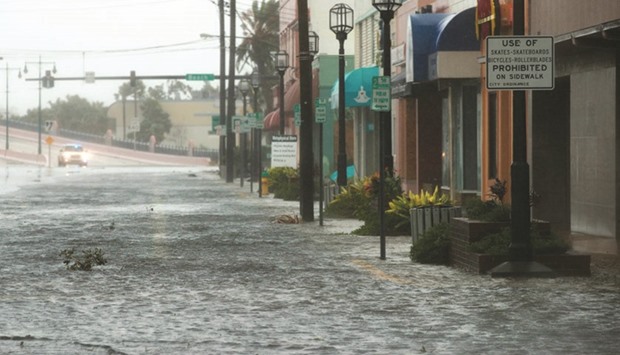Hurricane Matthew, carrying winds of 195kph, lashed central Florida yesterday, hugging the Atlantic coast as it moved north and threatening more destruction after killing nearly hundreds in Haiti.
Matthew, the first major hurricane to threaten a direct hit on the US in more than a decade, triggered mass evacuations along the coast from Florida through Georgia and into South Carolina and North Carolina.
Southern parts of Florida escaped the brunt of the storm overnight, but authorities yesterday urged people further north not to get complacent.
The Florida coastal city of Jacksonville could face significant flooding, Florida governor Rick Scott warned.
The storm had cut power to some 600,000 households, he told a news conference.
“The winds are ferocious right now,” said Jeff Piotrowski, a 40-year-old storm chaser from Tulsa, Oklahoma, who was near Cape Canaveral early yesterday.
The storm downed power lines and trees and destroyed billboards in Cape Canaveral, he said.
No significant damage or injuries were reported in West Palm Beach and other communities in south Florida where the storm had brought down trees and power lines earlier in the night, CNN and local media reported.
But Craig Fugate, director of the Federal Emergency Management Agency, said in media interviews he was concerned that relatively light damage so far could give people further north a false sense of security.
“People should not be looking at the damages they’re seeing and saying this storm is not that bad,” Fugate told NBC.
He also said people should be aware the hurricane carried more than just ferocious winds. “The real danger still is storm surge, particularly in northern Florida and southern Georgia. These are very vulnerable areas.
“They’ve never seen this kind of damage potential since the late 1800s.”
“It’s still a very dangerous situation,” he said.
Nasa and the US Air Force, which operate the Cape Canaveral launch site, had taken steps to safeguard personnel and equipment. A team of 116 employees was bunkered down inside Kennedy Space Center’s launch control centre to ride out the hurricane.
In West Palm Beach, street lights and houses went dark and Interstate 95 was empty as the storm rolled through the community of 100,000 people.
Matthew lessened in intensity on Thursday night and into yesterday morning, the National Hurricane Center said.
From an extremely dangerous Category 4 storm, it became a Category 3 on the five-step Saffir-Simpson scale of hurricane intensity, but was still a major storm.
The US National Weather Service said the storm could be the most powerful to strike northeast Florida in 118 years.
The NHC’s director, Rick Knabb, said that although Matthew was so far raking the coast, with its eye offshore, it still posed great danger to residents along the coast.
“You don’t have to be near the centre of the hurricane to be in the centre of action with inland flooding,” he said in a webcast.
The NHC’s hurricane warning extended up the Atlantic coast from southern Florida through Georgia and into South Carolina.
The last major hurricane, classified as a storm bearing sustained winds of more than 177kph, to make landfall on US shores was Hurricane Wilma in 2005.
Damage and potential casualties in the Bahamas were still unclear as the storm passed near the capital, Nassau, on Thursday and then moved out over the western end of Grand Bahama Island.
Governor Scott has urged some 1.5mn people in coastal areas of Florida to evacuate and he continued to urge people to move away from danger early yesterday. “You still have time to evacuate. There’s no reason to be taking risks,” Scott told NBC’s Today programme. “The most important thing to me is that we don’t lose one life.”
As of Friday morning, about 22,000 people were in Florida shelters and more moved inland or to the state’s west coast, Scott said.
Georgia and South Carolina had also opened dozens of shelters for evacuees.
Those states, as well as North Carolina, declared states of emergency, empowering their governors to mobilize the National Guard.
President Barack Obama declared states of emergency in Florida, Georgia and South Carolina, a move that authorised federal agencies to co-ordinate disaster relief efforts.

Water covers portions of International Speedway Boulevard in Daytona Beach after Hurricane Matthew passes through yesterday. Florida, Georgia, South Carolina and North Carolina have all declared a state of emergency.


